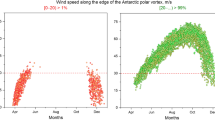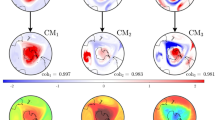Abstract
The relationship of N2O distributions with the Arctic vortex breakup is first analyzed with a probability distribution function (PDF) analysis. The N2O concentration shows different distributions between the early and late vortex breakup years. In the early breakup years, the N2O concentration shows low values and large dispersions after the vortex breakup, which is related to the inhomogeneity in the vertical advection in the middle and high latitude lower stratosphere. The horizontal diffusion coefficient (K yy) shows a larger value accordingly. In the late breakup years, the N2O concentration shows high values and more uniform distributions than in the early years after the vortex breakup, with a smaller vertical advection and K yy after the vortex breakup. It is found that the N2O distributions are largely affected by the Arctic vortex breakup time but the dynamically defined vortex breakup time is not the only factor.
Similar content being viewed by others
References
Akiyoshi, H., 2000: Modeling of chemistry-radiation coupling processes for the middle atmosphere and a numerical experiment on CO2 doubling with a 1-D coupled model. J. Meteor. Soc. Japan, 78, 563–584.
Akiyoshi, H., and M. Uryu, 1992: Diagnostic model study of the seasonal variation of global ozone and the Antarctic ozone hole. J. Geophys. Res., 97, 20,837–20,853.
Akiyoshi, H., S. Sugata, T. Sugita, H. Nagajima, H. Hayashi, J. Kurokawa, and M. Takahashi, 2002a: Low-N2O air masses after the breakup of the Arctic polar vortex in 1997 simulated by the CCSR/NIES nudging CTM. J. Meteor. Soc. Japan, 80, 451–463.
Akiyoshi, H., S. Sugata, T. Sugita, H. Nagajima, H. Hayashi, J. Kurokawa, and M. Takahashi, 2002b: Correction to “Low-N2O air masses after the breakup of the Arctic polar vortex in 1997 simulated by the CCSR/NIES nudging CTM”. J. Meteor. Soc. Japan, 80, 1308.
Brasseur, G., and S. Solomon, 1986: Aeronomy of the Middle Atmosphere. D. Reidel Publishing Company, Dordrecht, Holland, 452pp.
Fleming, E. L., C. H. Jackman, R. S. Stolarski, and D. B. Considine, 1999: Simulation of stratospheric tracers using an improved empirically based two-dimensional model transport formulation. J. Geophys. Res., 104, 23 911–23 934.
Fleming, E. L., C. H. Jackman, D. B. Considine, and R. S. Stolarski, 2001: Sensitivity of tracers and a stratospheric aircraft perturbation to two-dimensional model transport variations. J. Geophys. Res., 106, 14245–14263.
Hartmann, D. L., 1978: A note concerning the effects of varying extinction on radiative-photochemical relaxation. J. Atmos. Sci., 35, 1125–1130.
Herman, R. L., and Coauthors, 1998: Tropical entrainment time scales from stratospheric N2O and CH4 observations. Geophys. Res. Lett., 25, 2781–2784.
Hess, P. G., 1991: Mixing processes following the final stratospheric warming. J. Atmos. Sci., 48, 1625–1641.
Holton, J. R., 1986: Meridional distribution of stratospheric tracer constituents. J. Atmos. Sci., 43, 1238–1242.
Mahlman, J. D., H. Levy II, and W. J. Moxim, 1986: Three-dimensional simulations of stratospheric N2O: Predictions for other tracer constituents. J. Geophys. Res., 91, 2687–2707.
Nakamura, N., and J. Ma, 1997: Modified Lagrangianmean diagnosis of the stratospheric polar vortices. 2. N2O and seasonal barrier migration in the CLAES and SKYHI general circulation model. J. Geophys. Res., 102, 25,721–25,735.
Nash, E. R., P. A. Newman, J. E. Rosenfield, and M. R. Schoeberl, 1996: An objective determination of the polar vortex using Ertel’s potential vorticity. J. Geophys. Res., 101, 9471–9478.
Newman, P. A., M. R. Schoeberl, R. L. Plumb, and J. E. Rosenfield, 1988: Mixing rates calculated from potential vorticity. J. Geophys. Res., 93, 5221–5240.
Orsolini, Y. J., 2001: Long-lived tracer patterns in the summer polar stratosphere. Geophys. Res. Lett., 28, 3855–3858.
Sparling, L. C., 2000: Statistical perspectives on stratospheric transport. Rev. Geophys., 38, 417–436.
Strunk, M., A. Engel, U. Schmidt, C. M. Volk, T. Wetter, I. Levin, H. Glatzel-Matteier, 2000: CO2 and SF6 as stratospheric age tracers: Consistency and the effect of mesospheric SF6 loss. Geophys. Res. Lett., 25, 341–344.
Yang, H., 1995: Three-dimensional transport of Ertel potential vorticity and N2O in the GFDL SKYHI model. J. Atmos. Sci., 52, 1513–1528.
Yang, H., K. K. Tung, and E. Olaguer, 1990: Non-geostrophic theory of zonally averaged circulation. Part II: Eliassen-Palm flux divergence and isentropic mixing coefficient. J. Atmos. Sci., 47, 215–241.
Waugh, D. W., and P. P. Rong, 2002: Interannual variability in the decay of lower stratospheric Arctic vortices. J. Meteor. Soc. Japan, 80, 997–1012.
Waugh, D. W., K. K. Kelly, P. A. Newman, and L. R. Lait, 1997: Mixing of polar vortex air into middle latitudes as revealed by tracer-tracer scatter plots. J. Geophys. Res., 102, 13,119–13,134.
Waugh, D. W., W. J. Randel, S. Pawson, P. A. Newman, and E. R. Nash, 1999: Persistence of the lower stratospheric polar vortices. J. Geophys. Res., 104, 27,191–27,201.
WMO (World Meteorological Organization), 2003: Scientific Assessment of Ozone Depletion: 2002. Rep. 47. Global Ozone Res. and Monit. Proj., Geneva, Switzerland.
Zhou, S. T., M. E. Gelman, A. J. Miller, and J. P. McCormack, 2000: An inter-hemisphere comparison of the persistent stratospheric polar vortex. Geophys. Res. Lett., 27, 1123–1126.
Author information
Authors and Affiliations
Rights and permissions
About this article
Cite this article
Zhou, L., Zou, H. & Gao, Y. Middle-high latitude N2O distributions related to the Arctic vortex breakup. Adv. Atmos. Sci. 23, 215–223 (2006). https://doi.org/10.1007/s00376-006-0215-y
Received:
Revised:
Issue Date:
DOI: https://doi.org/10.1007/s00376-006-0215-y




